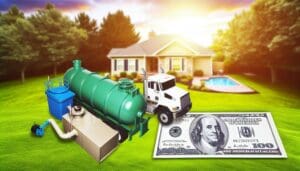Discover how to protect your septic system from breakdown with...
Read MoreYou & Your Septic Tank
From Sludge To Soil: How We Transform Waste Into Fertilizer With Septic Tank Pumping
Our professional septic service team offers comprehensive septic tank pumping services to keep your system running smoothly. Get a FREE Quote Today.

From Sludge To Soil: How We Transform Waste Into Fertilizer With Septic Tank Pumping
Have you ever caught yourself daydreaming about breaking free from the chains of store-bought fertilizer and paving your way to a greener, more sustainable garden? I know I have.
As a septic tank pumping expert and waste-to-fertilizer enthusiast, I’ve spent years perfecting the art of transforming sludge into soil. And let me tell you, my friends – it’s an exhilarating journey that leads not only to healthier plants but also to a greater sense of personal empowerment.
In this article, we’ll dive deep into the world of turning household waste into valuable organic matter for our gardens through septic tank pumping. You might be surprised at just how liberating it can feel to take control over your own waste management system – one flush at a time!
From understanding the science behind decomposition to learning practical tips on maintaining your septic system, we’re here to help guide you towards becoming a self-sufficient horticultural hero with thriving crops nurtured by nature’s best-kept secret: human waste turned fertilizer. Let’s get started on this transformative adventure together!
Understanding The Science Of Decomposition
You might be wondering, what’s the secret behind turning waste into something valuable? Well, my friends, it’s all about understanding the fascinating science of decomposition.
As a septic tank pumping and waste-to-fertilizer expert, I’ve seen firsthand how microbial breakdown plays an integral role in transforming sludge into nutrient-rich soil – providing essential soil nutrition to support healthy plant growth.
Now let me share with you some insights on how this amazing process works. When organic matter breaks down through natural processes, microbes begin decomposing the material by consuming it as their food source. In turn, they release valuable nutrients back into the soil that plants can then absorb for optimal health and growth.
It may sound simple enough, but there are several factors at play that influence the efficiency of this decomposition process: temperature, moisture content, and oxygen levels being just a few examples. By mastering these variables in our septic tank pumping services, we’re able to accelerate nature’s own recycling system and create fertile soil from once-wasted resources.
So without further ado, allow me to delve deeper into how septic tank pumping contributes positively towards sustainable agriculture practices…
Benefits Of Septic Tank Pumping
Now that we’ve delved into the fascinating world of decomposition, it’s time to explore the wonderful benefits septic tank pumping brings not only to our homes but also to our environment.
You see, by transforming waste into a valuable resource like fertilizer, we’re actively promoting eco-friendly and sustainable farming practices – which means healthier soil for growing crops and more nutritious food on our tables!
Plus, this method significantly contributes to water conservation as well; when wastewater is treated properly through septic tank systems, less strain is put on our precious water resources.
And there’s more good news: By investing in regular septic tank pumping services, you’ll be giving your support to maintaining healthy soil and conserving water – two essential elements for life on Earth.
Remember that healthy soils are critical for plant growth and food production while clean water supplies are vital for both human consumption and ecosystems’ survival.
So go ahead, embrace the power of septic tank pumping – not just because it keeps your home running smoothly or prevents unpleasant odors, but because it plays an important role in preserving our planet’s health too.
With all these amazing benefits waiting for you, let’s now move forward with discovering how to select the perfect septic tank pump tailored specifically for your needs.
How To Select The Right Septic Tank Pump
Who doesn’t enjoy shopping for septic tank pumps, am I right? It’s the thrill of the hunt that keeps us going!
In all seriousness, though, selecting the right pump is crucial to ensure smooth operation and optimal waste-to-fertilizer transformation. Let me share some expert tips on how to choose a suitable one while keeping in mind factors like pump maintenance and septic safety.
- Size matters: Choose a pump with appropriate capacity for your family size and water usage.
- Quality first: Invest in a reliable brand or model known for durability and performance.
- Energy efficiency: Opt for an energy-efficient pump to save money in the long run.
- Pump maintenance: Ensure easy access for regular inspection and servicing.
- Septic safety features: Look out for built-in alarms or sensors to detect potential issues early.
Now that you’ve got your perfect septic tank pump picked out, it’s time we look at maintaining its functionality throughout its lifespan. After all, what good is having top-notch equipment if it isn’t properly taken care of?
Up next: diving into how you can keep your system running smoothly and efficiently so that you can sleep soundly knowing your home’s waste management is well under control.
Maintaining A Functional Septic System
Now that you’ve got a better understanding of how to choose the right septic tank pump, let’s dive into keeping your entire system running smoothly.
A well-maintained septic system not only protects your family and property but also contributes positively to our environment by transforming waste into valuable fertilizer. So, it’s essential for all of us to do our part in maintaining a functional septic system.
To ensure an efficient wastewater treatment process, start with having a properly designed septic system installed on your property. Work closely with experts who understand the intricacies of septic design and can recommend appropriate solutions tailored to your home’s specific needs.
Regular inspections and timely maintenance are crucial too – this includes pumping out sludge when needed as well as checking for any potential issues such as leaks or blockages. By taking care of these aspects diligently, you’ll be able to enjoy the benefits of a clean, eco-friendly household while contributing toward creating natural fertilizers from waste products.
Next up: exploring some natural fertilizer alternatives that could enhance your gardening experience even further!
Natural Fertilizer Alternatives
As the saying goes, ‘one man’s trash is another man’s treasure.’ Indeed, it rings true when we explore alternative sources of natural fertilizers that contribute to green initiatives. These eco-friendly alternatives not only help us reduce our waste generation but also provide valuable nutrients required for healthy plant growth.
Below are some excellent options I’ve discovered in my journey as a septic tank pumping and waste-to-fertilizer expert:
- Grass clippings: Rich in nitrogen, grass clippings decompose quickly and can be spread directly on garden beds.
- Coffee grounds: A great source of nitrogen, potassium, and phosphorus; used coffee grounds can be mixed into soil or added to compost piles.
- Eggshells: Crushed eggshells add calcium to the soil, which helps strengthen cell walls and prevent common diseases like blossom end rot in tomatoes.
- Wood ash: Containing potassium and trace elements, wood ash from untreated lumber can be sprinkled around plants or incorporated into compost bins.
- Animal manure: Rabbit, chicken, sheep, horse, or cow manures are all rich in various essential nutrients for plants.
The beauty lies in how these everyday items transform into nourishing food for our gardens without any guilt-inducing environmental impact. As you become more conscious about your ecological footprint – think twice before discarding those seemingly useless kitchen scraps! You might just find yourself with an abundant harvest come summertime.
Now that you’re familiar with these organic fertilizer alternatives let’s move forward together by exploring the world of composting basics.
Composting Basics
As we’ve explored the world of natural fertilizer alternatives, it’s evident that there are many options available to help us nurture our gardens and landscapes in an eco-friendly way. But wait – there’s more! Composting is another fantastic method to turn waste into nutrient-rich soil amendments for your garden, especially when you’re looking to support native plants.
One exciting composting technique I recommend giving a try is vermicomposting, which utilizes worms (usually red wigglers) to break down organic materials like food scraps and yard waste.
The worm castings produced by this process make for an incredibly rich and fertile addition to your soil, allowing native plants to flourish without any synthetic fertilizers. Plus, getting started with vermicomposting is super easy: all you need is a suitable bin or container, some bedding material such as shredded newspaper or coconut coir, and of course, worms!
Soon enough, you’ll be on your way toward creating beautiful outdoor spaces while also contributing positively to the environment. Up next, let’s take a closer look at how embracing composting can bring about numerous benefits not just for our gardens but also for ourselves and Mother Nature herself.
The Benefits Of Composting
You might be wondering, ‘What’s the big deal about composting? Why should I care?’
Well my friend, let me tell you just how essential this process can be for environmental sustainability and overall well-being. As a septic tank pumping and waste-to-fertilizer expert, I’ve witnessed firsthand the incredible transformation that occurs when we take something seemingly useless – like sludge – and turn it into a valuable resource.
By embracing alternative methods of dealing with our waste, we not only help protect our planet but also tap into an innate desire for liberation from traditional, environmentally harmful practices.
Now imagine if everyone started utilizing composting as part of their daily lives; think about the significant positive impact on our environment! We would reduce landfill waste, decrease greenhouse gas emissions, and replenish nutrient-rich soil suitable for growing healthy food.
More importantly, by taking charge in such a simple yet meaningful way, we are fostering a sense of connection to the Earth and promoting responsible stewardship of its resources. So whether you’re already an avid composter or considering giving it a try for the first time, remember that every bit counts towards creating a greener future for generations to come.
Now that we’ve explored these benefits, let’s dive deeper into bio-cleaning solutions for septic tanks – another remarkable method making strides toward sustainable living.
Bio-Cleaning Solutions For Septic Tanks
Now that we’ve explored the wonders of composting, let’s dive into another eco-friendly method to give our environment a helping hand – bio-cleaning solutions for septic tanks.
Our trusty septic systems do more than just manage waste; they can also contribute in turning wastewater into valuable fertilizer through sewage treatment and greywater recycling. This whole process is nothing short of magical!
Harnessing nature’s power, these innovative bio-cleaning solutions use naturally occurring bacteria to break down organic matter found in your septic tank. By doing so, it significantly reduces sludge build-up and keeps harmful toxins at bay.
Additionally, this environmentally friendly approach allows you to recycle greywater from sinks, showers, and laundry machines for garden irrigation or even flushing toilets! So not only are you giving back to Mother Earth by reducing water consumption but you’re also transforming waste into natural fertilizer – talk about a win-win situation!
Next up: rainwater harvesting for an evergreen revolution in fertilization.
Rainwater Harvesting For Fertilizer
Now, I know what you might be thinking: ‘Rainwater as fertilizer? Isn’t that just water?’ Well, let me tell you, my friend – there’s more to it than meets the eye. By implementing proper rainwater harvesting techniques and filtration systems, we can create nutrient-rich water that will give your plants a major boost in growth and health.
Let’s dive into four essential aspects of collecting and utilizing rainwater for fertilization:
- Collection: Set up a well-designed system to collect and store rainwater from roofs or other surfaces where it falls freely. This typically involves installing gutters and downspouts that direct rainfall towards barrels or cisterns.
- Filtration: Take advantage of natural rainwater filtration methods by using layers of gravel, sand, and activated charcoal in your storage tanks to remove debris and contaminants before they reach your plants.
- Enrichment: Boost the nutrient content of harvested rainwater by adding compost tea or worm castings – these organic materials contain beneficial microorganisms which help break down nutrients into forms that are easier for plants to absorb.
- Application: Use drip irrigation systems or soaker hoses to deliver the enriched rainwater directly to plant roots, ensuring efficient distribution with minimal evaporation loss.
By integrating these steps into our gardening routine, not only do we reduce dependence on unsustainable resources like chemically treated municipal water supplies but also work harmoniously with nature while encouraging self-sufficiency within our homes.
So grab those tools! Next up, let’s explore some DIY fertilizer recipes for greener gardens together, healthier plants, and a more sustainable and eco-friendly lifestyle.
Happy gardening!
Diy Fertilizer Recipes For Greener Gardens
Now that we’ve discussed how septic tank pumping can transform waste into fertilizer, let’s explore some do-it-yourself (DIY) fertilizer recipes to create a greener and more fruitful garden. As an expert in both the septic tank industry and waste-to-fertilizer transformation, I’m excited to share my knowledge with you all! These DIY fertilizers are not only cost-effective but also environmentally friendly – perfect for those seeking liberation from chemical-laden store-bought alternatives.
To help you get started on your journey towards healthier soil and thriving plants, here’s a table of four simple yet effective homemade fertilizer recipes using everyday household items. These planting techniques combined with proper soil amendments will significantly improve the quality of your garden while also reducing waste!
| Ingredients | Fertilizer Benefits |
|---|---|
| Coffee grounds | Adds nitrogen, potassium and phosphorus to the soil; promotes plant growth |
| Crushed eggshells | Provides calcium which strengthens cell walls & prevents blossom end rot in tomatoes |
| Banana peels (chopped or buried whole) | Slowly releases potassium, phosphorus and magnesium; great for flowering plants and fruiting trees |
| Epsom salt solution (1 tablespoon per gallon of water) | Boosts levels of magnesium and sulfur; enhances photosynthesis & root development |
Feel free to experiment with these DIY fertilizer recipes based on your garden’s specific needs. Remember that healthy soil is key to nurturing strong roots, vibrant blooms, and bountiful harvests. So go ahead – harness the power of nature by transforming everyday waste into nourishment for your cherished outdoor space. The earth (and your wallet) will thank you!
Frequently Asked Questions
What Are The Potential Health Risks Associated With Using Septic Tank Waste As Fertilizer, And How Can They Be Mitigated?
Let me paint you a picture – imagine a lush, green field filled with crops that have been fertilized using septic tank waste.
Now I know what you’re thinking: ‘What are the potential health risks associated with using septic tank waste as fertilizer, and how can they be mitigated?’
As an expert in septic tank pumping and transforming waste into fertilizer, let me assure you there’s nothing to worry about if we follow proper procedures.
For example, water quality and soil health play crucial roles when it comes to this process. By treating the wastewater properly before applying it to fields, harmful pathogens and contaminants can be removed or reduced significantly.
This not only improves our overall environment but also allows us to free ourselves from the constraints of conventional fertilizers while promoting sustainable agriculture.
Trust me; turning sludge into fertile soil is both safe and liberating!
Are There Any Specific Plants Or Crops That Should Not Be Fertilized With Septic Tank Waste, Due To Potential Contamination Or Other Concerns?
You bet there are certain plants and crops that we should be cautious about fertilizing with septic tank waste!
To ensure the safety of our food supply, it’s crucial to follow proper testing protocols for potential contaminants and consider various soil types in which these plants grow.
As a seasoned expert in septic tank pumping and waste-to-fertilizer transformation, I can assure you that being diligent about these factors is key to unlocking the full benefits of this eco-friendly fertilization method.
By staying informed and taking necessary precautions, we’re not only nurturing healthier gardens but also contributing to a greener planet – now that’s true liberation for both us and Mother Earth!
How Do Local Regulations And Guidelines Vary Regarding The Use Of Septic Tank Waste As Fertilizer, And What Steps Should Be Taken To Ensure Compliance?
You might be wondering about the local regulations and guidelines when it comes to using septic tank waste as fertilizer. Well, let me tell you that these can vary significantly depending on where you live.
As a septic tank pumping and waste-to-fertilizer expert, I strongly advise staying up-to-date with your area’s specific requirements for both septic maintenance and tank maintenance. It’s crucial to ensure compliance by contacting your local health department or environmental agency for information on the proper use of septic waste in agriculture.
This way, not only will you contribute to a more sustainable environment, but you’ll also experience that liberating feeling of knowing you’re turning what was once considered ‘waste’ into something incredibly valuable – nutrient-rich soil!
What Are The Environmental Impacts Of Using Septic Tank Waste As Fertilizer, Compared To Traditional Synthetic Fertilizers And Other Organic Alternatives?
Like a carefully balanced recipe, using septic tank waste as fertilizer can have its benefits and drawbacks when compared to traditional synthetic fertilizers and other organic alternatives.
As an expert in septic tank pumping and waste-to-fertilizer conversion, I can tell you that one of the key factors we need to consider is water quality.
When used correctly, septic waste-based fertilizers can actually help improve water quality by reducing nutrient runoff into nearby rivers and streams.
On the flip side, if not managed properly, these same nutrients could pose risks to our precious aquatic ecosystems.
That’s why soil testing is so crucial—it helps us determine the right balance of nutrients for your specific plot of land while ensuring compliance with local regulations.
Ultimately, it’s all about finding harmony between our desire for a greener future and the practicalities of managing waste in an environmentally responsible way—a liberation from typical constraints through innovative thinking and careful planning.
Are There Any Innovative Technologies Or Methods Being Developed To Further Improve The Efficiency And Safety Of Transforming Septic Tank Waste Into Fertilizer?
We’re constantly on the lookout for innovative technologies and methods to improve the efficiency and safety of turning septic tank waste into fertilizer.
By embracing cutting-edge recycling techniques, we can ensure that our process is not only safe but also eco-friendly.
Soil testing plays a crucial role in this journey, as it allows us to fine-tune our approach for maximum nutrient delivery while minimizing any potential hazards.
Together, let’s break free from conventional thinking and embrace these exciting new possibilities!
As experts in septic tank pumping and waste-to-fertilizer transformation, we know that looking forward is the key to unlocking a greener future for all of us – so let’s keep pushing boundaries together!
Conclusion
In the grand tapestry of agriculture, transforming septic tank waste into fertilizer is akin to alchemy; we turn something seemingly useless and harmful into a valuable resource. However, it’s vital that we remain vigilant in mitigating potential health risks associated with this practice.
By carefully selecting suitable plants, adhering to local regulations, and implementing innovative methods, we can weave together an environmentally friendly approach towards sustainable farming.
As stewards of our environment, we must continue seeking greener pastures by exploring alternatives to traditional synthetic fertilizers. Septic tank waste offers us a golden opportunity to nourish our soil while reducing pollution and preserving precious resources. It’s truly a remarkable example of how nature provides solutions for its own challenges when given a chance.
So let us roll up our sleeves and delve deeper into the world of waste-to-fertilizer transformation as responsible custodians of Mother Earth. With diligence and innovation on our side, we’ll create a harmonious balance between agricultural progress and environmental conservation – an ode to the circle of life itself.
You may also like...
Why Are DIY Fixes Essential for Septic Tank Pumping?
Tap into the importance of DIY fixes for septic tank...
Read MoreUnveiling the Average Costs of Septic Tank Pumping
Master the mysteries of septic tank pumping costs and avoid...
Read More
The Best Septic Tank Pumping Services Near You

Answer Some Questions
Let us know about your needs so we can find you the right septic tank pros.

Get Quotes
We will put you in touch with the right septic tank pros for your job and location.

Hire Right
Compare quotes, message or call pros, and hire only when ready.



